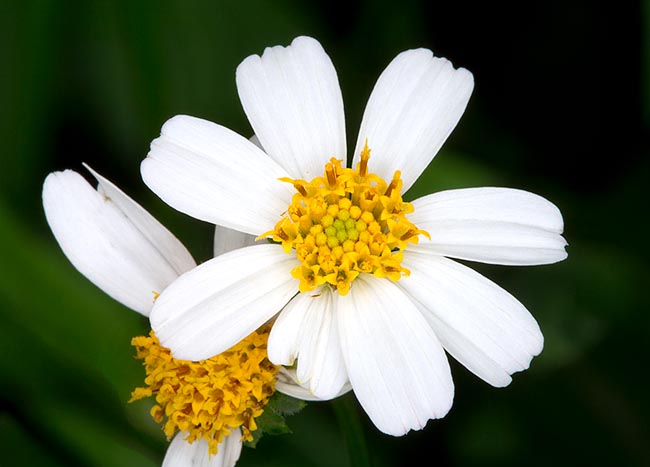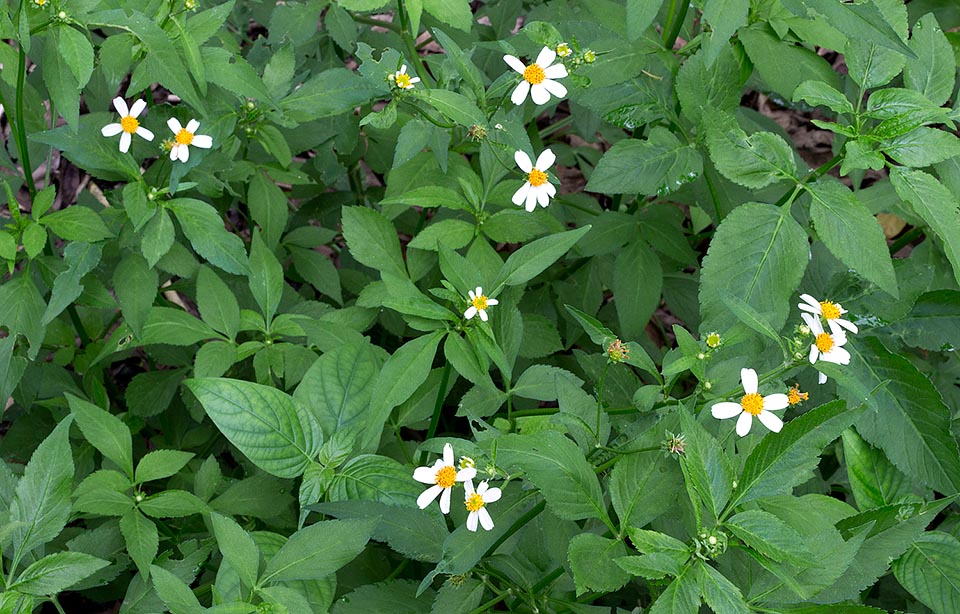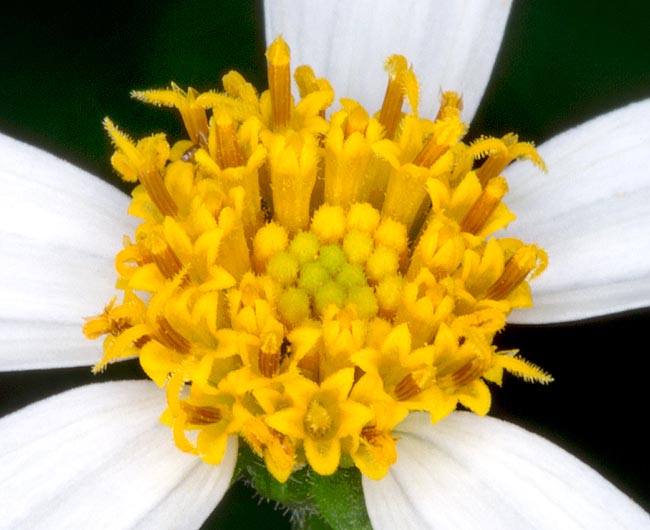Family : Asteraceae

Text © Pietro Puccio

English translation by Mario Beltramini

Bidens pilosa, native to Tropical America, lives in usually poor soils in open areas, at the forests margins, along the waterstreams and disturbed zones, from the sea level up to about 2000 m of altitude © Giuseppe Mazza
The species is native to Antigua and Barbuda, Argentina, Barbados, Belize, Brazil (Paranà, Rio Grande do Sul and Santa Catarina), Chile, Colombia, Costa Rica, Cuba, Dominican Republic, Ecuador, Guadeloupe, Guatemala, Guyana, Haiti, Honduras, Jamaica, Martinica, Mexico (Aguascalientes, Baja Norte, Baja Sur, Chiapas, Coahuila, Colima, Distretto Federale, Durango, Guanajuato, Guerrero, Hidalgo, Jalisco, Mexico, Michoacan, Nayarit, Nuevo Leon, Oaxaca, Queretaro, San Luis Potosi, Sinaloa, Sonora, Tamaulipas, Veracruz and Zacatecas), Montserrat, Nicaragua, Panama, Peru, Puerto Rico, Saint Kitts and Nevis, Saint Lucia, Saint Vincent and the Grenadines, Uruguay, USA (California) and Venezuela where lives on usually poor soils in open areas, at the margins of the forests, along the water streams and in disturbed areas, from the sea level up to about 2000 m of altitude.
The generic name comes from the Latin “bidens” = with two teeth (from “bis” = twice and “dens” = tooth), with reference to the bristles present on the fruits (achenes) of some species belonging to the genus; the specific name is the Latin adjective “pilosus, a, um” = hairy, with reference to the hair present on the leaves.
Common names: beggar-ticks, black-jack, bur marigold, cobblers’-pegs, hairy beggar-ticks, hairy bidens, Spanish-needles (English); gui zhen cao, san yeh kuei jen tsao (Chinese); bident hérissé, bident poilu, herbe d’aiguille, herbe villebague, piquant noir (French); jaringan, caringan, hareuga (Indonesian); forbicina, forbicina pelosa (Italian); carrapicho-de-agulha, picão-preto (Portuguese); bidente piloso, mozote (Spanish); Zweizahn (German).
The Bidens pilosa L. (1753) is an annual herbaceous species with erect stems with almost quadrangular section, up to 1,8 m tall in favorable conditions, slightly pubescent, more or less ramified.
The leaves, on a 1,5 cm long petiole, are opposite, of very variable shape, simple, ovate to lanceolate with serrate margins, 3-10 cm long and 1-4 cm broad, or pennate with 3-7 ovate to lanceolate lobes, 2-8 cm long and 1-4 cm broad, of intense green colour.

Annual herbaceous species, has erect stem with almost quadrangular section, that may even be 1,8 m tall. Naturalized and infestant in various tropical and subtropical zones, has edible leaves and medicinal virtues. Recent laboratory studies have already evidenced antimalarial properties of the leaves extracts © Giuseppe Mazza
The capitulum is formed by a crowd of sessile flowers spirally arranged on a roundish base, the receptacle, of about 0,6 cm of diameter, surrounded by an involucre formed by a series of bracts, usually 7 to 10, linear to spatulate, 0,4 cm long, green, with ciliate margins.
The flowers of the outer ring, called ray florets, usually in number of 5 to 8, have ovate corolla with tridentate apex, 0,5-1,5 cm long, white or yellowish; the ray florets may at times be totally absent.
The ray florets are sterile and have the function of attracting the pollinator like the petals of a single flower. The flowers inside the ring, called disc florets, in number of 20-60, are bisexual, with tubular corolla, 0,3-0,5 cm long, of yellow colour.
The fruits are achenes (or, better, cypselae), the outer ones, rather flat and linear, 0,5 cm long, bristly, reddish brown, the inner ones are fusiform with almost quadrangular section, 0,7-1,5 cm long and 0,1 cm broad, blackish, possibly with 2, at times 3, rigid, erect pappi provided of tiny retroflexed scales having the function of favouring their dispersion through the animals; one single plant can produce more than 3000 seeds.

The capitulum is formed by many sessile flowers spirally arranged on a roundish base. The disc florets, bisexual, are 20-60; the ray ones, sterile, may be absent, but usually they are 5-8 © Giuseppe Mazza
Amply diffused species in the origin countries and naturalized in various areas of the world, where has become in many cases a pest, growing in a wide variety of soils, even at high salinity, and of climates, competing with many native species up to prevent their growth.
The sprouts and the young leaves are locally consumed, raw or cooked, as vegetable during famine times.
Roots, leaves and seeds contain several bioactive compounds and are variously and amply utilized in the traditional medicine for various pathologies, in the origin countries as well as in those where it has naturalized; laboratory studies have already evidenced antimalarial properties of the leaves extracts and are under way researches for evaluating their effectiveness in others field of the medicine.
Synonyms: Coreopsis alba L. (1753); Coreopsis leucantha L. (1763); Bidens cannabina Lam. (1779); Bidens pinnata Noronha (1790); Bidens trifoliata Norona (1790); Coreopsis leucorrhiza Lour. (1790); Bidens odorata Cav. (1791); Kerneria tetragona Moench (1794); Bidens hybrida Thuill. (1799); Bidens leucantha (L.) Willd. (1803); Coreopsis odorata Poir. (1811); Ceratocephalus pilosus Rich. ex Cass. (1817); Bidens alausensis Kunth (1820); Bidens hispida Kunth (1820); Bidens scandicina Kunth (1820); Bidens pumila (Retz.) Steud. (1821); Bidens reflexa Link (1822); Kerneria dubia Cass. (1822); Coreopsis odorata Lam. (1823); Bidens sundaica Blume (1826); Bidens adhaerescens Vell. (1827); Bidens striata Schott ex Sweet (1828); Glossogyne chinensis Less. (1832); Bidens valparadisiaca Colla (1835); Bidens abadiae DC. (1836); Bidens alba (L.) DC. (1836); Bidens brachycarpa DC. (1836); Bidens californica DC. (1836); Bidens caracasana DC. (1836); Bidens caucalidea DC. (1836); Bidens chilensis DC. (1836); Bidens daucifolia DC. (1836); Bidens dichotoma Desf. ex DC. (1836); Bidens exaristata DC. (1836); Bidens leucantha Poepp. ex DC. (1836); Coreopsis corymbifolia Buch.-Ham. ex DC. (1836); Coreopsis multifida DC. (1836); Bidens tripartita Bojer (1837); Bidens decussata Pav. ex Steud. (1840); Bidens paleacea Vis. (1840); Bidens hirsuta Nutt. (1841); Bidens hirta Jord. (1850); Bidens bimucronata Turcz (1851); Bidens bonplandii Sch.Bip. (1856); Bidens rosea Sch.Bip. (1856); Kerneria pilosa (L.) Lowe (1860); Bidens arenaria Gand. (1875); Bidens arenicola Gand. (1875); Bidens inermis S.Watson (1888); Bidens orientalis Velen. ex Bornm. (1888); Bidens montaubani Phil. (1891); Bidens aurantiaca Colenso (1895); Bidens africana Klatt (1896); Bidens leucanthemus (L.) E.H.L.Krause (1905); Bidens viciosoi Pau (1908); Bidens minuscula H.Lév. & Vaniot (1910); Bidens taquetii H.Lév. & Vaniot (1910); Bidens deamii Sherff (1913); Bidens ramosissima Sherff (1913); Bidens barrancae M.E.Jones (1933); Bidens orendainae M.E.Jones (1933); Bidens effusa Thuill. ex Sherff (1937); Bidens minor (Wimm. & Grab.) Vorosch. (1949).
→ To appreciate the biodiversity within the ASTERACEAE family please click here.
